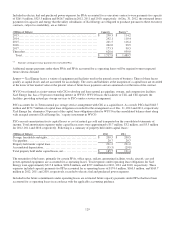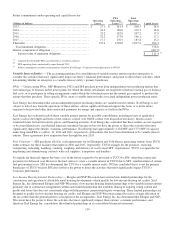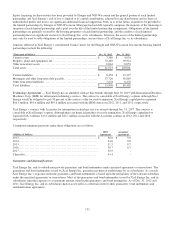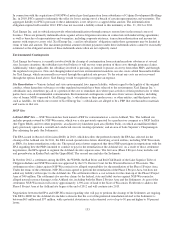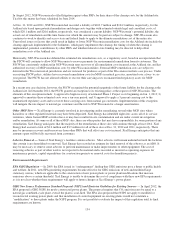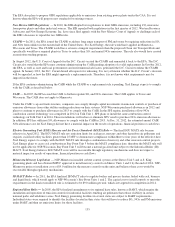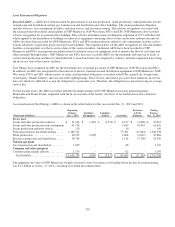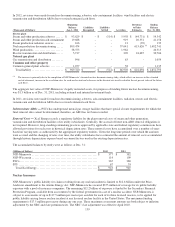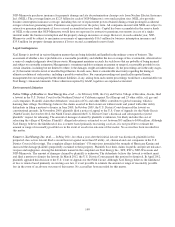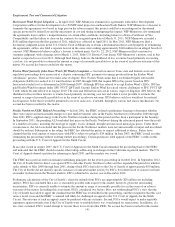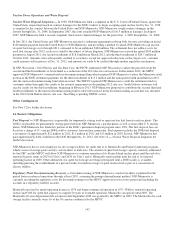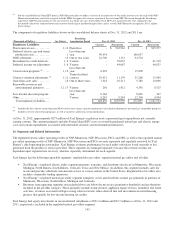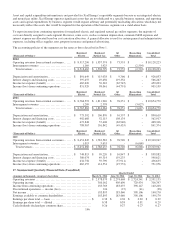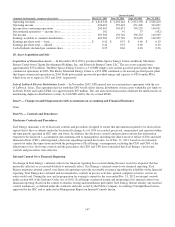Xcel Energy 2012 Annual Report Download - page 147
Download and view the complete annual report
Please find page 147 of the 2012 Xcel Energy annual report below. You can navigate through the pages in the report by either clicking on the pages listed below, or by using the keyword search tool below to find specific information within the annual report.
137
SPS
Harrington Units 1 and 2 are potentially subject to BART. Texas has developed a SIP (the Texas SIP) that finds the CAIR equal
to BART for EGUs. As a result, no additional controls beyond CAIR compliance would be required. In May 2012, the EPA
deferred its review of the Texas SIP in its final rule allowing states to find that CSAPR compliance meets BART requirements for
EGUs. It is not yet known how the D.C. Circuit’s reversal of the CSAPR may impact the EPA’s approval of the Texas SIP.
Revisions to National Ambient Air Quality Standards (NAAQS) for PM — In December 2012, the EPA lowered the primary
health-based NAAQS for annual average fine PM and retained the current daily standard for fine PM. In areas where Xcel Energy
operates power plants, current monitored air concentrations are below the level of the final annual primary standard. The EPA is
expected to designate non-compliant locations by December 2014. States would then study the sources of the nonattainment and
make emission reduction plans to attain the standards. It is not possible to evaluate the impact of this regulation further until the
final designations have been made.
Federal Clean Water Act (CWA) Section 316 (b) — The federal CWA requires the EPA to regulate cooling water intake
structures to assure that these structures reflect the best technology available for minimizing adverse environmental impacts to
aquatic species. In 2011, the EPA published the proposed rule that sets standards for minimization of aquatic species
impingement, but leaves entrainment reduction requirements at the discretion of the permit writer and the regional EPA office.
The proposed rule is expected to be finalized in July 2013. It is not possible to provide an accurate estimate of the overall cost of
this rulemaking at this time due to the uncertainty of the final regulatory requirements.
NSP-Minnesota submitted its Black Dog CWA compliance plan for MPCA review and approval in 2010. The MPCA is currently
reviewing the proposal in consultation with the EPA.
Proposed Coal Ash Regulation — Xcel Energy’s operations are subject to federal and state laws that impose requirements for
handling, storage, treatment and disposal of hazardous waste. In 2010, the EPA published a proposed rule on whether to regulate
coal combustion byproducts (coal ash) as hazardous or nonhazardous waste. Coal ash is currently exempt from hazardous waste
regulation. Xcel Energy’s costs for the management and disposal of coal ash would significantly increase and the beneficial reuse
of coal ash would be negatively impacted if the EPA ultimately issues a rule under which coal ash is regulated as hazardous
waste. The EPA has not announced a planned date for a final rule. The timing, scope and potential cost of any final rule that might
be implemented are not determinable at this time.
PSCo Notice of Violation — In 2002, PSCo received an NOV from the EPA alleging violations of the New Source Review
(NSR) requirements of the CAA at the Comanche Station and Pawnee Generating Station in Colorado. The NOV alleges that
various maintenance, repair and replacement projects at the plants in the mid to late 1990s should have required a permit under
the NSR process. PSCo believes it has acted in full compliance with the CAA and NSR process. PSCo also believes that the
projects identified in the NOV fit within the routine maintenance, repair and replacement exemption contained within the NSR
regulations or are otherwise not subject to the NSR requirements. PSCo disagrees with the assertions contained in the NOV and
intends to vigorously defend its position. It is not known whether any costs would be incurred as a result of this NOV.
NSP-Minnesota NOV — In 2011, NSP-Minnesota received an NOV from the EPA alleging violations of the NSR requirements
of the CAA at the Sherco plant and Black Dog plant in Minnesota. The NOV alleges that various maintenance, repair and
replacement projects at the plants in the mid 2000s should have required a permit under the NSR process. NSP-Minnesota
believes it has acted in full compliance with the CAA and NSR process. NSP-Minnesota also believes that the projects identified
in the NOV fit within the routine maintenance, repair and replacement exemption contained within the NSR regulations or are
otherwise not subject to the NSR requirements. NSP-Minnesota disagrees with the assertions contained in the NOV and intends to
vigorously defend its position. It is not known whether any costs would be incurred as a result of this NOV.




